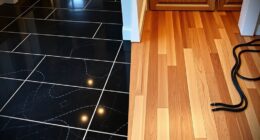We have all encountered the unpleasent consequences of a hot shower – a foggy mirror, damp walls, and excessive humidity. Did you know that insulating your bathroom exhaust duct can aid in avoiding these problems?
In this article, we’ll explore the importance of insulating bathroom exhaust ducts, from energy efficiency benefits to compliance with building codes. Discover how this simple upgrade can enhance your bathroom’s performance, reduce noise transmission, and keep condensation at bay.
Let’s dive into the world of bathroom exhaust duct insulation.
Key Takeaways
- Insulating bathroom exhaust ducts enhances bathroom performance by preventing condensation, heat loss, and moisture buildup.
- Insulation reduces noise transmission and improves energy efficiency, leading to savings on utility bills and decreased greenhouse gas emissions.
- Proper insulation prevents condensation and mold growth, improving indoor air quality and overall ventilation system efficiency.
- Insulating the duct helps maintain compliance with building codes, ensures safety, and prevents air leakage and potential damage.
Importance of Insulating Bathroom Exhaust Ducts
We believe that insulating bathroom exhaust ducts is of utmost importance for optimal ventilation.

The installation process for insulated bathroom exhaust ducts involves a few key steps.
First, you need to measure the length and diameter of the existing duct to determine the amount of insulation required.
Next, you’ll need to purchase the appropriate insulation material, such as foam or fiberglass insulation.
Once you have the insulation, you can begin the installation process by wrapping it around the duct, making sure to cover all areas evenly.

Finally, secure the insulation in place using adhesive tape or metal clips.
When considering the cost of insulating bathroom exhaust ducts, it’s essential to factor in the cost of materials, labor if hiring a professional, and potential energy savings in the long run.
Insulating bathroom exhaust ducts can help prevent condensation, reduce heat loss or gain, and improve overall energy efficiency.
Energy Efficiency Benefits of Insulation
Insulating bathroom exhaust ducts provides numerous energy efficiency benefits. By adding insulation to the ducts, the temperature of the air passing through can be better regulated, resulting in reduced energy consumption. This not only saves money on utility bills, but also has a positive environmental impact by reducing greenhouse gas emissions.

Insulation helps to prevent heat loss or gain, depending on the season, by creating a barrier between the duct and the surrounding environment. This improves the overall efficiency of the ventilation system and reduces the workload on heating and cooling systems. Additionally, insulation minimizes the formation of condensation inside the ducts, preventing moisture-related issues such as mold growth and structural damage.
To illustrate the cost effectiveness and environmental impact of insulating bathroom exhaust ducts, consider the following table:
| Energy Efficiency Benefits | Description |
|---|---|
| Reduced energy consumption | Insulation helps regulate air temperature, reducing the need for heating or cooling. |
| Lower utility bills | By using less energy, homeowners can save money on their monthly utility bills. |
| Decreased greenhouse gas emissions | Less energy consumption means reduced environmental impact and carbon footprint. |
| Prevents condensation | Insulation helps prevent condensation inside the ducts, minimizing the risk of mold growth and structural damage. |
| Improved overall efficiency | Insulation improves the overall efficiency of the ventilation system, reducing the workload on heating and cooling systems. |
Prevention of Condensation and Moisture Buildup
To prevent condensation and moisture buildup, insulating the bathroom exhaust duct is essential. When warm, moist air from the bathroom is expelled through the exhaust duct, it can come into contact with the cooler air surrounding the duct. This temperature difference can cause the moisture in the air to condense, leading to water accumulation and potential mold growth within the duct.
By insulating the duct, we can maintain a consistent temperature, preventing condensation and reducing the risk of mold formation. Additionally, insulating the duct helps improve indoor air quality by preventing moisture from entering other areas of the house, which can cause damage and promote the growth of mold and mildew.

Therefore, proper insulation of the bathroom exhaust duct is crucial for preventing mold growth and improving indoor air quality.
Reduction of Noise Transmission
Effective insulation of the bathroom exhaust duct helps in reducing noise transmission. Insulating the duct can provide several benefits, including:
- Soundproofing options: Insulating the bathroom exhaust duct can help to minimize the noise from the fan, reducing the sound that travels through the duct and into other areas of the home. This can create a quieter and more peaceful environment, especially in bedrooms or living spaces adjacent to the bathroom.
- Impact on indoor air quality: Insulating the bathroom exhaust duct can also help to prevent the infiltration of outdoor pollutants and allergens into the home. By sealing the duct, insulation can help maintain a cleaner and healthier indoor environment by preventing the entry of dust, pollen, and other contaminants.
- Enhanced energy efficiency: Insulation can also improve the energy efficiency of the bathroom exhaust system by minimizing heat loss or gain through the duct. This can help to reduce energy consumption and lower heating or cooling costs.
Proper insulation of the bathroom exhaust duct is crucial for reducing noise transmission and improving indoor air quality. Consider soundproofing options and choose insulation materials that are safe and effective for your specific needs.
Compliance With Building Codes and Regulations
We must ensure that our bathroom exhaust duct is compliant with building codes and regulations. Building code requirements and safety regulations play a crucial role in ensuring the safety and efficiency of our exhaust system.

Compliance with these codes and regulations helps to prevent potential hazards and ensures that the exhaust duct functions properly. Building codes specify the materials, dimensions, and installation requirements for the exhaust duct, while safety regulations outline the necessary measures for fire safety and ventilation.
It’s essential to adhere to these guidelines to avoid costly penalties, potential damage to the property, and to ensure the well-being of occupants. By following the building code requirements and safety regulations, we can ensure a safe and efficient bathroom exhaust system.
Frequently Asked Questions
What Are the Potential Health Risks Associated With Uninsulated Bathroom Exhaust Ducts?
Uninsulated bathroom exhaust ducts can pose potential health risks due to condensation and moisture buildup, leading to mold and mildew growth. This can decrease ventilation effectiveness and result in poor air quality.
Can Insulation Help Prevent the Growth of Mold and Mildew in Bathroom Exhaust Ducts?
Insulating the bathroom exhaust duct can prevent condensation and reduce energy loss. It also helps in preventing the growth of mold and mildew. Overall, insulation is crucial for maintaining a healthy and efficient ventilation system.

How Does Insulation Impact the Lifespan of Bathroom Exhaust Fans?
Insulation significantly impacts the lifespan of bathroom exhaust fans by reducing the strain on the motor, preventing overheating, and improving energy efficiency. Insulated exhaust ducts also provide better air quality and help prevent condensation and mold growth.
Are There Any Fire Safety Concerns Related to Uninsulated Bathroom Exhaust Ducts?
There can be fire safety concerns associated with uninsulated bathroom exhaust ducts. Uninsulated ducts can potentially overheat and ignite nearby combustible materials, leading to health risks and property damage.
Does Insulation Affect the Overall Cost of Installing or Maintaining Bathroom Exhaust Systems?
Insulating bathroom exhaust ducts can improve energy efficiency and reduce heat loss. While it may increase upfront costs, the long-term cost effectiveness of insulation makes it a worthwhile investment in maintaining and operating bathroom exhaust systems.
Conclusion
In conclusion, insulating bathroom exhaust ducts is crucial for several reasons.

Not only does it improve energy efficiency by reducing heat loss or gain, but it also prevents condensation and moisture buildup, which can lead to mold growth.
Additionally, insulation helps to minimize noise transmission, creating a quieter bathroom environment.
It’s important to note that insulating bathroom exhaust ducts is often required by building codes and regulations.
Did you know that properly insulated ducts can reduce energy consumption by up to 20%?











